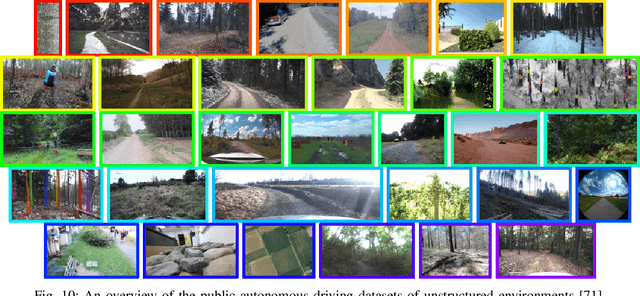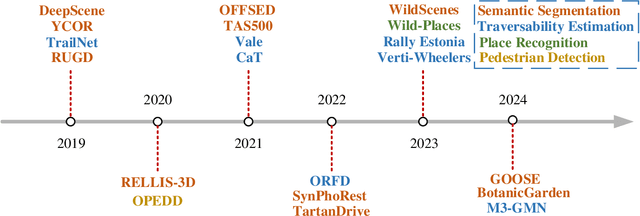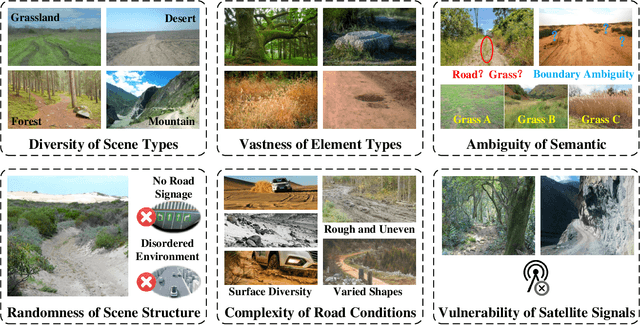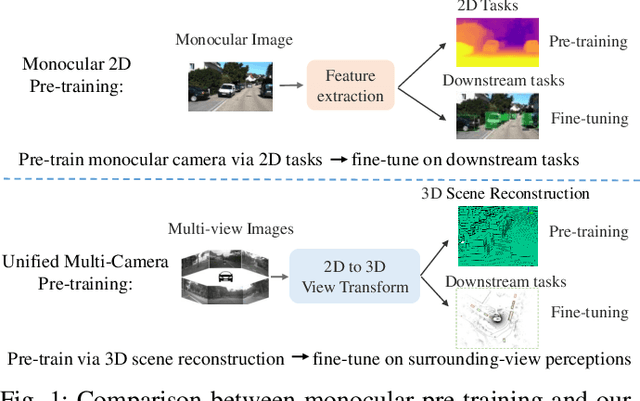Chen Min
UNIV: Unified Foundation Model for Infrared and Visible Modalities
Sep 19, 2025Abstract:The demand for joint RGB-visible and infrared perception is growing rapidly, particularly to achieve robust performance under diverse weather conditions. Although pre-trained models for RGB-visible and infrared data excel in their respective domains, they often underperform in multimodal scenarios, such as autonomous vehicles equipped with both sensors. To address this challenge, we propose a biologically inspired UNified foundation model for Infrared and Visible modalities (UNIV), featuring two key innovations. First, we introduce Patch-wise Cross-modality Contrastive Learning (PCCL), an attention-guided distillation framework that mimics retinal horizontal cells' lateral inhibition, which enables effective cross-modal feature alignment while remaining compatible with any transformer-based architecture. Second, our dual-knowledge preservation mechanism emulates the retina's bipolar cell signal routing - combining LoRA adapters (2% added parameters) with synchronous distillation to prevent catastrophic forgetting, thereby replicating the retina's photopic (cone-driven) and scotopic (rod-driven) functionality. To support cross-modal learning, we introduce the MVIP dataset, the most comprehensive visible-infrared benchmark to date. It contains 98,992 precisely aligned image pairs spanning diverse scenarios. Extensive experiments demonstrate UNIV's superior performance on infrared tasks (+1.7 mIoU in semantic segmentation and +0.7 mAP in object detection) while maintaining 99%+ of the baseline performance on visible RGB tasks. Our code is available at https://github.com/fangyuanmao/UNIV.
An Efficient Real-Time Planning Method for Swarm Robotics Based on an Optimal Virtual Tube
May 02, 2025Abstract:Swarm robotics navigating through unknown obstacle environments is an emerging research area that faces challenges. Performing tasks in such environments requires swarms to achieve autonomous localization, perception, decision-making, control, and planning. The limited computational resources of onboard platforms present significant challenges for planning and control. Reactive planners offer low computational demands and high re-planning frequencies but lack predictive capabilities, often resulting in local minima. Long-horizon planners, on the other hand, can perform multi-step predictions to reduce deadlocks but cost much computation, leading to lower re-planning frequencies. This paper proposes a real-time optimal virtual tube planning method for swarm robotics in unknown environments, which generates approximate solutions for optimal trajectories through affine functions. As a result, the computational complexity of approximate solutions is $O(n_t)$, where $n_t$ is the number of parameters in the trajectory, thereby significantly reducing the overall computational burden. By integrating reactive methods, the proposed method enables low-computation, safe swarm motion in unknown environments. The effectiveness of the proposed method is validated through several simulations and experiments.
Semantic Scene Completion Based 3D Traversability Estimation for Off-Road Terrains
Dec 11, 2024Abstract:Off-road environments present significant challenges for autonomous ground vehicles due to the absence of structured roads and the presence of complex obstacles, such as uneven terrain, vegetation, and occlusions. Traditional perception algorithms, designed primarily for structured environments, often fail under these conditions, leading to inaccurate traversability estimations. In this paper, ORDformer, a novel multimodal method that combines LiDAR point clouds with monocular images, is proposed to generate dense traversable occupancy predictions from a forward-facing perspective. By integrating multimodal data, environmental feature extraction is enhanced, which is crucial for accurate occupancy estimation in complex terrains. Furthermore, RELLIS-OCC, a dataset with 3D traversable occupancy annotations, is introduced, incorporating geometric features such as step height, slope, and unevenness. Through a comprehensive analysis of vehicle obstacle-crossing conditions and the incorporation of vehicle body structure constraints, four traversability cost labels are generated: lethal, medium-cost, low-cost, and free. Experimental results demonstrate that ORDformer outperforms existing approaches in 3D traversable area recognition, particularly in off-road environments with irregular geometries and partial occlusions. Specifically, ORDformer achieves over a 20\% improvement in scene completion IoU compared to other models. The proposed framework is scalable and adaptable to various vehicle platforms, allowing for adjustments to occupancy grid parameters and the integration of advanced dynamic models for traversability cost estimation.
WildOcc: A Benchmark for Off-Road 3D Semantic Occupancy Prediction
Oct 21, 2024Abstract:3D semantic occupancy prediction is an essential part of autonomous driving, focusing on capturing the geometric details of scenes. Off-road environments are rich in geometric information, therefore it is suitable for 3D semantic occupancy prediction tasks to reconstruct such scenes. However, most of researches concentrate on on-road environments, and few methods are designed for off-road 3D semantic occupancy prediction due to the lack of relevant datasets and benchmarks. In response to this gap, we introduce WildOcc, to our knowledge, the first benchmark to provide dense occupancy annotations for off-road 3D semantic occupancy prediction tasks. A ground truth generation pipeline is proposed in this paper, which employs a coarse-to-fine reconstruction to achieve a more realistic result. Moreover, we introduce a multi-modal 3D semantic occupancy prediction framework, which fuses spatio-temporal information from multi-frame images and point clouds at voxel level. In addition, a cross-modality distillation function is introduced, which transfers geometric knowledge from point clouds to image features.
Autonomous Driving in Unstructured Environments: How Far Have We Come?
Oct 10, 2024



Abstract:Research on autonomous driving in unstructured outdoor environments is less advanced than in structured urban settings due to challenges like environmental diversities and scene complexity. These environments-such as rural areas and rugged terrains-pose unique obstacles that are not common in structured urban areas. Despite these difficulties, autonomous driving in unstructured outdoor environments is crucial for applications in agriculture, mining, and military operations. Our survey reviews over 250 papers for autonomous driving in unstructured outdoor environments, covering offline mapping, pose estimation, environmental perception, path planning, end-to-end autonomous driving, datasets, and relevant challenges. We also discuss emerging trends and future research directions. This review aims to consolidate knowledge and encourage further research for autonomous driving in unstructured environments. To support ongoing work, we maintain an active repository with up-to-date literature and open-source projects at: https://github.com/chaytonmin/Survey-Autonomous-Driving-in-Unstructured-Environments.
DriveWorld: 4D Pre-trained Scene Understanding via World Models for Autonomous Driving
May 07, 2024Abstract:Vision-centric autonomous driving has recently raised wide attention due to its lower cost. Pre-training is essential for extracting a universal representation. However, current vision-centric pre-training typically relies on either 2D or 3D pre-text tasks, overlooking the temporal characteristics of autonomous driving as a 4D scene understanding task. In this paper, we address this challenge by introducing a world model-based autonomous driving 4D representation learning framework, dubbed \emph{DriveWorld}, which is capable of pre-training from multi-camera driving videos in a spatio-temporal fashion. Specifically, we propose a Memory State-Space Model for spatio-temporal modelling, which consists of a Dynamic Memory Bank module for learning temporal-aware latent dynamics to predict future changes and a Static Scene Propagation module for learning spatial-aware latent statics to offer comprehensive scene contexts. We additionally introduce a Task Prompt to decouple task-aware features for various downstream tasks. The experiments demonstrate that DriveWorld delivers promising results on various autonomous driving tasks. When pre-trained with the OpenScene dataset, DriveWorld achieves a 7.5% increase in mAP for 3D object detection, a 3.0% increase in IoU for online mapping, a 5.0% increase in AMOTA for multi-object tracking, a 0.1m decrease in minADE for motion forecasting, a 3.0% increase in IoU for occupancy prediction, and a 0.34m reduction in average L2 error for planning.
Is Sora a World Simulator? A Comprehensive Survey on General World Models and Beyond
May 06, 2024Abstract:General world models represent a crucial pathway toward achieving Artificial General Intelligence (AGI), serving as the cornerstone for various applications ranging from virtual environments to decision-making systems. Recently, the emergence of the Sora model has attained significant attention due to its remarkable simulation capabilities, which exhibits an incipient comprehension of physical laws. In this survey, we embark on a comprehensive exploration of the latest advancements in world models. Our analysis navigates through the forefront of generative methodologies in video generation, where world models stand as pivotal constructs facilitating the synthesis of highly realistic visual content. Additionally, we scrutinize the burgeoning field of autonomous-driving world models, meticulously delineating their indispensable role in reshaping transportation and urban mobility. Furthermore, we delve into the intricacies inherent in world models deployed within autonomous agents, shedding light on their profound significance in enabling intelligent interactions within dynamic environmental contexts. At last, we examine challenges and limitations of world models, and discuss their potential future directions. We hope this survey can serve as a foundational reference for the research community and inspire continued innovation. This survey will be regularly updated at: https://github.com/GigaAI-research/General-World-Models-Survey.
Adaptive Learning for Multi-view Stereo Reconstruction
Apr 08, 2024Abstract:Deep learning has recently demonstrated its excellent performance on the task of multi-view stereo (MVS). However, loss functions applied for deep MVS are rarely studied. In this paper, we first analyze existing loss functions' properties for deep depth based MVS approaches. Regression based loss leads to inaccurate continuous results by computing mathematical expectation, while classification based loss outputs discretized depth values. To this end, we then propose a novel loss function, named adaptive Wasserstein loss, which is able to narrow down the difference between the true and predicted probability distributions of depth. Besides, a simple but effective offset module is introduced to better achieve sub-pixel prediction accuracy. Extensive experiments on different benchmarks, including DTU, Tanks and Temples and BlendedMVS, show that the proposed method with the adaptive Wasserstein loss and the offset module achieves state-of-the-art performance.
UniWorld: Autonomous Driving Pre-training via World Models
Aug 14, 2023Abstract:In this paper, we draw inspiration from Alberto Elfes' pioneering work in 1989, where he introduced the concept of the occupancy grid as World Models for robots. We imbue the robot with a spatial-temporal world model, termed UniWorld, to perceive its surroundings and predict the future behavior of other participants. UniWorld involves initially predicting 4D geometric occupancy as the World Models for foundational stage and subsequently fine-tuning on downstream tasks. UniWorld can estimate missing information concerning the world state and predict plausible future states of the world. Besides, UniWorld's pre-training process is label-free, enabling the utilization of massive amounts of image-LiDAR pairs to build a Foundational Model.The proposed unified pre-training framework demonstrates promising results in key tasks such as motion prediction, multi-camera 3D object detection, and surrounding semantic scene completion. When compared to monocular pre-training methods on the nuScenes dataset, UniWorld shows a significant improvement of about 1.5% in IoU for motion prediction, 2.0% in mAP and 2.0% in NDS for multi-camera 3D object detection, as well as a 3% increase in mIoU for surrounding semantic scene completion. By adopting our unified pre-training method, a 25% reduction in 3D training annotation costs can be achieved, offering significant practical value for the implementation of real-world autonomous driving. Codes are publicly available at https://github.com/chaytonmin/UniWorld.
Occ-BEV: Multi-Camera Unified Pre-training via 3D Scene Reconstruction
Jun 07, 2023



Abstract:Multi-camera 3D perception has emerged as a prominent research field in autonomous driving, offering a viable and cost-effective alternative to LiDAR-based solutions. However, existing multi-camera algorithms primarily rely on monocular image pre-training, which overlooks the spatial and temporal correlations among different camera views. To address this limitation, we propose the first multi-camera unified pre-training framework called Occ-BEV, which involves initially reconstructing the 3D scene as the foundational stage and subsequently fine-tuning the model on downstream tasks. Specifically, a 3D decoder is designed for leveraging Bird's Eye View (BEV) features from multi-view images to predict the 3D geometric occupancy to enable the model to capture a more comprehensive understanding of the 3D environment. A significant benefit of Occ-BEV is its capability of utilizing a considerable volume of unlabeled image-LiDAR pairs for pre-training purposes. The proposed multi-camera unified pre-training framework demonstrates promising results in key tasks such as multi-camera 3D object detection and surrounding semantic scene completion. When compared to monocular pre-training methods on the nuScenes dataset, Occ-BEV shows a significant improvement of about 2.0% in mAP and 2.0% in NDS for multi-camera 3D object detection, as well as a 3% increase in mIoU for surrounding semantic scene completion. Codes are publicly available at https://github.com/chaytonmin/Occ-BEV.
 Add to Chrome
Add to Chrome Add to Firefox
Add to Firefox Add to Edge
Add to Edge